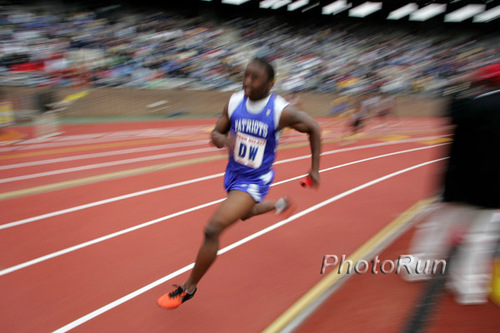April 24, 2014
A significant number of the sport’s aficionados consider the Penn Relay Carnival to be the finest, grandest track & field contest in the country. While those who have come to love the Prefontaine Classic may wish to differ, a compelling case can be made that the revered Philadelphia springtime fixture – now in the midst of its 120th running – is the nation’s premier meet.
While Penn is a special three-day kaleidoscope of preps, collegians, and pros, each day has its own unique personality. Day One serves up a high school and collegiate feast with a  daytime smorgasbord featuring a few finals, some qualifying races, and – amazingly – 47 different sections of the high school girls 4 x 400 relay – all expertly orchestrated to stay on an exacting time schedule.
daytime smorgasbord featuring a few finals, some qualifying races, and – amazingly – 47 different sections of the high school girls 4 x 400 relay – all expertly orchestrated to stay on an exacting time schedule.
The frenetic, non-stop afternoon relay scene is something to behold, but the special character of Penn Relays / Day One emerges just as the sun goes down – and as the temperature does as well. It is then that the heartiest of track & field stalwarts settle in for a chilly evening of highly-competitive collegiate championship distance medley relays and individual distance races. How impassioned is the Thursday night crowd? The more rabid fans position themselves in the northeast corner of Franklin Field to grab front row seats overlooking the icy pool of the steeplechase water jump. Are these the same ghoulish spectators who earlier in the week chose to watch the Boston Marathon from Heartbreak Hill?
The collegiate women’s championship distance medley race – an electrifying contest – got things off on the right foot. After two legs, four teams – Georgetown, Villanova, Stanford, and Oregon – had separated themselves from the field. When a spirited third leg battle failed to provide meaningful separation among the top quartet, it all come down – as it often does in the DMR – to the anchors. Who would have the biggest dog? Stanford anchor Aisling Cuffe wasted no time, rushing to the lead shortly after grabbing the baton. Villanova’s Emily Lipari quickly covered the Cardinal move as did Georgetown’s Rachel Schneider and Oregon’s Laura Roessler. Cuffe – who never let up on the gas – kept the heat on. When the Stanford junior’s relentless racing pressure finally forged a 6 meter lead on the backstretch of the last lap, the race appeared well in hand for the Palo Alto quartet. But never discount that Penn Relays magic. Villanova’s Lipari – a hometown favorite of the Franklin Field fans – suddenly found another gear. Exhorted onward by the crowd, the Wildcat anchor caught Cuffe in the middle of the homestretch to eke out a narrow ‘Nova victory. Lipari’s sparkling anchor leg [4:33.44] gave the Lady Wildcats a winning time of 10:57.35 and their 12th Penn Relays DMR victory. “I was definitely relaxed,” an exuberant Lipari explained. “All of the girls that were out there before me were out there being really tough. And for me not to give that same toughness would have been a shame.” Behind Stanford’s runner-up finish, Georgetown hung on for 3rd. Starting way back at the final exchange, 7-time NCAA champion Abbey D’Agostino ran her anchor leg in 4:35.10 to push Dartmouth up into the fourth position, just nipping Oregon.
With the sun dipping behind the ivy-covered walls of Franklin Field, the temperature began to drop as the collegiate men’s steeplechase final got underway. Large distance race fields are not uncommon at Penn and this race featured several dozen athletes. The field was bunched in the early going as the collegian steeplers exhibited caution in such a large field. Savvy athletes pay attention to a barrier placement oddity in Franklin Field. Customarily the water jump – normally located inside the track oval approximately 150 meters from the finish line – is followed by one final barrier on the homestretch before the finish. However the cramped quarters of Franklin Field necessitate an unusual steeple configuration – the placement of the water jump outside the track’s perimeter with a hurdle-less run in to the finish of about 80 meters. Connecticut College’s Michael LeDuc made such racing subtleties a non-factor as he cruised to an easy victory in the collegiate men’s steeplechase final posting a winning time of 8:47.94 – easily besting Texas A&M’s Isaac Spencer [8:53.92].
In the women’s collegiate steeplechase final, West Virginia’s Sarah Martinelli and Tori Gerlach of Penn State broke way early to dual alone at the front of the race. Gerlach – more proficient in clearing the barriers – exhibited quick turnover in pressing the pace while the loping Martinelli – a ragged hurdler – held on. The Mountaineer broke away as the bell lap began and had enough of an advantage to stave off the Nittany Lioness for the victory – 10:17.47 to 10:21.40. Post collegiate Brooks athlete Carmen Graves posted a 10:09.33 as she cruised to an easy win in the Olympic Development section of the women’s 3000 meter steeple final.
In the women’s 3000 meter final, Cornell’s Rachel Sorna was back to defend her 2013 Penn title. But the Providence duo of senior Laura Nagel and sophomore Sarah Collins – an athlete from Switzerland – had different ideas. The Friar pair took turns dishing out pacing punishment as the trio broke away from the sizeable field. But Sorna held on. On the final circuit, the defending champion – who spent most of the race shadowing the Providence athletes – swung wide at the top of the backstretch to initiate a final drive. But the Friar senior beat her to the punch, unleashing a withering kick that propelled her to victory in the winning time of 9:07.90. Sorna [9:09.45] finished second while the Swiss miss [9:11.97] held on for third.
In the college women’s 5000 meter final, Meghan McGlinchey was in control for 4999 meters of the race. Jumping out to an early lead, the La Salle athlete soon established what appeared to be a comfortable lead – a margin that grew to 30 meters with 3 laps remaining. But Kentucky’s Cally Macumber drove hard over the final circuit in an effort to close the gap. Weaving through lapped runners over the last 150 meters, Macumber caught an unsuspecting McGlinchey in the final stride. The Kentucky runner’s frantic last-second lean was just enough to give the Wildcat athlete [16:07.21] a narrow win over a most surprised McGlinchey [16:07.32]. Hannah Davidson [16:02.46] of Stotan Racing was victorious in the Olympic Development 5000 final.
Yale’s Kevin Dooney captured the collegiate men’s 5000 final with a winning time of 13:59.38 – good enough to better Indiana’s Evan Esselink who posted 14:01.67. Highly-touted Texas athlete Craig Lutz – a 2013 point scorer in the NCAA Div. I outdoor 5000 final – was a factor in the early stages of the race but did not finish.
Dropping temperatures made Franklin Field a lonely place as the 10,000 finals got underway. While the remaining fans bundled up and the pesky wind which hampered performances earlier in the day died away, the women’s 10,000 began. Penn State’s Leigha Anderson had an easy – albeit chilly – time of it clocking 33:52.32 which afforded her an easy, nearly 19 second victory. It wasn’t any warmer for the men’s 10,000. But those stoic fans who did remain were rewarded with a thrilling battle. Going right down to the wire, Chris Galvin of Texas [29:35.52] had just enough to nip Columbia’s Jack Boyle [29:35.83] for the win.
After the awards ceremony of the men’s 10,000, the remaining crowd – comprised solely of the hardest of hardcore fans satiated from a full day of track &
; field – wandered out of Franklin Field, slowly disappearing into the near-freezing darkness. To a person, they looked exhausted. Despite their uniformly-beleaguered appearance, there was no doubt: they would all be back tomorrow – and the next day. Dave Hunter
Author

Larry Eder has had a 52-year involvement in the sport of athletics. Larry has experienced the sport as an athlete, coach, magazine publisher, and now, journalist and blogger. His first article, on Don Bowden, America's first sub-4 minute miler, was published in RW in 1983. Larry has published several magazines on athletics, from American Athletics to the U.S. version of Spikes magazine. He currently manages the content and marketing development of the RunningNetwork, The Shoe Addicts, and RunBlogRun. Of RunBlogRun, his daily pilgrimage with the sport, Larry says: "I have to admit, I love traveling to far away meets, writing about the sport I love, and the athletes I respect, for my readers at runblogrun.com, the most of anything I have ever done, except, maybe running itself." Also does some updates for BBC Sports at key events, which he truly enjoys. Theme song: Greg Allman, " I'm no Angel."
View all posts





















